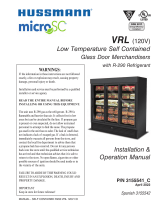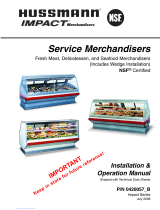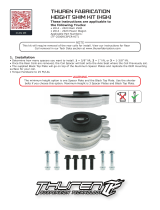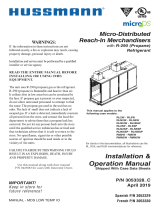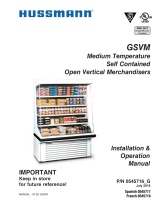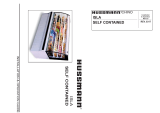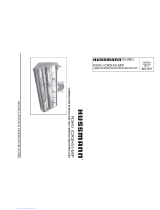Page is loading ...

SIM-4AA ISLAND
MERCHANDISER
with R-290 Refri
g
erant
DOE 2017
Energy
Efficiency
Compliant
Hussmann refrigerated merchandisers configured for sale for use in the United States
meet or surpass the requirements of the DOE 2017 energy efficiency standards.
WARNINGS :
If the information in these instructions are not followed
exactly, a fire or explosion may result, causing property
damage, personal injury or death.
Installation and service must be performed by a qualified
installer or service agency.
READ THE ENTIRE MANUAL BEFORE
INSTALLING OR USING THIS EQUIPMENT.
The unit uses R-290 gas as the refrigerant. R-290 is
flammable and heavier than air. It collects first in low
areas but can be circulated by the fans. If propane gas
is present or even suspected, do not allow untrained
personnel to attempt to find the cause.The propane
gas used in the unit has no odor. The lack of smell does
not indicate a lack of escaped gas. If a leak is detected,
immediately evacuate all persons from the store, and
contact the local fire department to advise them that
a propane leak has occurred. Do not let any persons
back into the store until the qualified service technician
hasarrivedandthattechnicianadvisesthatitissafeto
return to the store. No open flames, cigarettes or other
possible sources of ignition should be used inside or in
the vicinity of the units.
FAILURETOABIDE BYTHISWARNINGCOULD
RESULT IN AN EXPLOSION, DEATH, INJURYAND
PROPERTY DAMAGE.
IMPORTANT
Keep in store for future reference!
Installation &
Operation Manual
P/N 3179796999
May 2023

2
U.S. & Canada 1-800-922-1919 • Mexico 1 800-890-2900 • www.hussmann.com
BEFORE YOU BEGIN
Read these instructions completely and carefully.
PERSONAL PROTECTION EQUIPMENT (PPE)
Personal Protection Equipment (PPE) is required whenever installing or servicing this
equipment. Always wear safety glasses, gloves, protective boots or shoes, long pants, and a
long-sleeve shirt as required when installing or servicing this equipment.
1. If the information in these instructions are not followed exactly, a fire or explosion may result, causing property damage, personal injury
or death.
2. Installation and service must be performed by a qualified installer or service agency.
3. ThisunitisdesignedonlyforusewithR-290gasasthedesignatedrefrigerant.
THE REFRIGERANT LOOP IS SEALED. ONLY A QUALIFIED TECHNICIAN SHOULD ATTEMPT TO S E R V I C E !
• Propane is flammable and heavier than air.
• It collects first in the low areas but can be circulated by the fans.
• If R-290 is present or even suspected, do not allow untrained personnel to attempt to find the cause.
• The propane gas used in the unit has no odor.
• The lack of smell does not indicate a lack of escaped gas.
• If a leak is detected, immediately evacuate all persons from the store, and contact the local fire department to advise them that a
pro pane leak has occurred.
• Do not let any persons back into the store until the qualified service technician has arrived and that technician advises that it is
safe to return to the store.
• A hand-held propane leak detector (“sniffer”) shall be used before any repair and/or maintenance.
• No open flames, cigarettes or other possible sources of ignition should be used inside the building where the units are located
until the qualified service technician and/or local fire department determines that all propane has been cleared from the area and
from the refrigeration systems.
• Component parts are designed for propane and non-incendive and non-sparking. Component parts shall only be replaced with
identical repair parts.
FAILURE TO ABIDE BY THIS WARNING COULD RESULT IN AN EXPLOSION, DEATH, INJURY AND PROPERTY
DAMAGE.

3
ThiswarningdoesnotmeanthatHussmannproducts
willcausecancerorreproductiveharm,orisin
violationofanyproduct‐safetystandardsor
requirements.AsclarifiedbytheCaliforniaState
government,Proposition65canbeconsideredmore
ofa‘righttoknow’lawthanapureproductsafety
law.Whenusedasdesigned,Hussmannbelievesthat
ourproductsarenotharmful.Weprovidethe
Proposition65warningtostayincompliancewith
CaliforniaStatelaw.Itisyourresponsibilitytoprovide
accurateProposition65warninglabelstoyour
customerswhennecessary.Formoreinformationon
Proposition65,pleasevisittheCaliforniaState
governmentwebsite.
U.S. & Canada 1-800-922-1919 • Mexico 1 800-890-2900 • www.hussmann.com
* * * * * * * * * * * * * * * * * * * * * * * * * *
ANSI Z535.5 DEFINITIONS
•DANGER – Indicate[s] a hazardous
situation which, if not avoided, will
result in death or serious injury.
•WARNING – Indicate[s] a hazardous
situation which, if not avoided, could
result in death or serious injury.
•CAUTION – Indicate[s] a hazardous
situation which, if not avoided, could
result in minor or moderate injury.
•NOTICE – Not related to personal injury –
Indicates[s] situations, which if not avoided,
could result in damage to equipment.
Merchandiser must operate for 24 hours
before loading product!
Regularly check merchandiser temperatures.
Do not break the cold chain. Keep products
in freezer before loading into merchandiser.
These merchandisers are designed
for only pre-frozen products.
ATTENTION
—LOCKOUT/TAGOUT—
To avoid serious injury or death from electrical
shock, always disconnect the electrical power
at the main disconnect when servicing or
replacing any electrical component. This
includes, but is not limited to, such items as
doors, lights, fans, heaters, and thermostats.
Case ventilation openings must be clear of any
obstructions. Do not damage the refrigerant
circuit.
Do not use mechanical devices or other means
to accelerate the defrosting process.
Do not use electrical appliances inside the food
storage compartments of the case.
All installation and operating instructions
concerning the handling, moving, and use of
these merchandisers must be carefully followed
to avoid either damaging the refrigerant tubing,
or increasing the risk of a leak.

Table of Contents
4
CONTENT SUBCONTENT PAGE
NoticeonLoadingandHandling 5
GeneralInformation 6
SectionandPlanViews 7
Specifications/DataSheet 8
Installation
Preparation 9‐10
Lifting&Transporation‐ UsingJ‐Bars&Dollies 11
ForkLiftGuidance 12
MethodforLeveling 13
BodyPanels 14
UserInformation StartupandSetup 15
Checklist 16
Maintenance CleaningExteriorandInterior 17‐20
MaintenanceTips 20
Electrical
GeneralInformation 21
ComponentLocations 22
Self‐ContainedComponentLocations 23
ControllerInformation 24
WiringDiagramSIM4AA 25
Refrigeration
SerialPlateLocation/Piping/LineSizing/OilTraps 26
Serviceand/orRepair 27‐29
WaterOutlet 29
TroubleShooting 30‐31
Service EvaporatorFanReplacement 32
PerimeterPlexReplacement 33
PartsDiagram 34
PartsList 35

Notice
WARNING
IMPORTANT
‐DONOTATTEMPTTOMOVE
THEMERCHANDISERBY
APPLYINGFORCETOTHEUPPER
PLEXAREA(EVENIFWOODEN
BRACESAREPRESENT)
‐APPLYPUSHINGFORCESNEAR
THELINER/TUBAREAINORDER
TOBRINGMERCHANDISERSTO
THEFINALPOSITION
‐DONOTLoadorstandoverthetopofthecase.
Glassbreakagemayoccurifprecautionsaredisregarded
*Brokenglasscancauselacerations,cuts,andpuncturewoundswhichmayresultseveredarteries
ortendons,amputations,eyeinjuries,orexposuretodisease.
5

General Information
CaseDescription:
Description: Island Merchandiser
Shipping Damage: All equipment should be thoroughly examined for shipping damage before and
during unloading. This equipment has been carefully inspected at our factory and the carrier has
assumed responsibility for safe arrival. If damaged, either apparent or concealed, claim must be
made to the carrier Immediately.
Apparent Loss or Damage: If there is an obvious loss or damage, it must be noted on the freight bill
or express receipt and signed by the carrier’s agent; otherwise, carrier may refuse claim. The carrier
will supply necessary claim forms.
Concealed Loss or Damage: When loss or damage is not apparent until after all equipment is
uncrated, a claim for concealed damage is made. Make request in writing to carrier for inspection
within 15 days and retain all packaging. The carrier will supply inspection report and required claim
forms.
Shortages: Check your shipment for any possible shortages of material. If a shortage should exist
and is found to be the responsibility of Hussmann, notify Hussmann. If such a shortage involves the
carrier, notify the carrier immediately, and request an inspection. Hussmann will acknowledge
shortages within ten days from receipt of equipment.
Hussmann Product Control: The serial number and shipping date of all equipment have been
recorded in Hussmann’s files for warranty and replacement part purposes. All correspondence
pertaining to warranty or parts ordering must include the serial number of each piece of equipment
involved, in order to provide the customer with the correct parts.
Location/Store Conditions: The SIM-AA island merchandiser has been designed for use only in air-
conditioned stores where temperature and humidity are maintained at or below 75°F Dry bulb and
55% relative humidity. The case is also rated to operate in Type 2 conditions (80F / 55%RH). See
specification sheets for setting changes. DO NOT allow air conditioning, electric fans, ovens, open
doors or windows (etc.) to create air currents around the merchandiser, as this will impair its correct
operation.
Keep this booklet with the case at all times for future reference.
ATTENTION
INSTALLER
This equipment is to be installed
to comply with the applicable
NEC, Federal, State, and Local
Plumbing and Construction
Code having jurisdiction.
6

Case Sections
SIM-AA
ISLAND
Case Plan Views
SIM4AA
7

Specifications 8
R-290 Charge size of 150 grams

Snapping Chalk Lines
Mark floors with Chalk snap lines where cases
are to be located. Chalk lines are to run along
the base or legs of cases.
Receiving Case and Preparing for Installation
Prepare By:
1. Inspect equipment for damage. Any claim for loss or
damage must be made to the carrier. The carrier will
provide any necessary inspection/claim form. If
there is obvious loss or damage, it must be noted on
the freight bill or express receipt and signed by the
carrier’s agent; otherwise carrier may refuse claim.
2. Read instructions and warnings on handling and
transportation. Ensure the proper transportation
equipment is being used.
3. Survey and mark out the installation area and plan
footprint. Snapping chalk lines is recommended.
IMPORTANT
‐PLASTICWRAPMAYBEREMOVEDTOACCESSPARTS,WARNINGS,ANDINSTRUCTIONS
Installation – Preparation
9

Receiving Case and Preparing for Installation
Installation – Preparation
10
Unpacking:
(Cordless drill or Screwdriver required)
1. Remove top section of crate.
2. Remove all 4 crate sides.
3. Remove all 4 shipping brackets from case & pallet.
4. Lift & slide case off pallet and place on floor or dollies.
J-bar maybe used to lift case (see next page for placement).

Installation – Lifting and Transportation – Using J-Bars and Dollies
SIM-AA Transportation Using Dollies
Using J-Bars to get the merchandizer onto Dollies for transportation is the preferred and recommend
technique for getting the case to its final location.
1. The SIM-AA can be lifted with a J-Bar high enough to place furniture dollies under each base leg.
2. Engage the SIM-AA from the points illustrated in the Graphic Below.
3. Remove lower body panels before lifting with a J-Bar to prevent damage.
4. Ensure the case is balanced before attempting to place on dollies. Reposition J-Bar if necessary.
5. Lift the case only as high as necessary to place a dolly.
6. Repeat the procedure at the other end and in the center as necessary.
7. SIM4AA (base legs) cases require 2 dollies.
8. Evenly support the entire base structure on rollers or dollies before attempting to move.
Each Base Leg must have its own dolly to properly support the case.
A. Safe J-Bar Lift Point at the front/back of the case.
B. Safe J-Bar Lift Point at the side of the case
(same left or right).
C. Each base leg should be support by a dolly. Do
not place dollies between base leg spans.
11

Installation – Lifting and Transportation – Fork-Lift Guidance
SIM-AA Transportation using Fork-Lifts
Using J-Bars and Dollies are the preferred technique, but a Fork-Lift can be used if the special
requirements stated below are met
1. Remove lower body panels before lifting with a forklift to prevent damage
2. Before lifting the case, be sure forklift blades clear all casters. See Graphic Below.
3. The case can be raised at one end under the base leg to allow for placement of dollies.
12

Important: See the suggestions for setting cases on uneven floors before setting lineups and
leveling cases. Using this suggestion will result in the fewest required adjustments to case
levels.
Installation – Method for Leveling SIM-AA Merchandizers
Level the Case sequentially, Using Metal Shims
1. Check levelness left-to-right first (This usually requires the most correction on a single side)
2. Adjust front-to-back levelness after ensuring left-to-right levelness (Shims normally inserted in pairs during
this check).
Important: Always level the first case in the lineup. All other cases should be
driven from its levels. See “Uneven Floor Guidance” for details.
Note: The use of metal shims is recommended in order to prevent shim
deterioration over time
13

Installing Front and Side Body Panel
A Philips Screwdriver / Drill bit will be required in order to install or remove Front and Side Body Panels.
Lift panel up and place hook into opening on case and slide down. See Graphic Below. Fasten at
indicated locations.
Installing Rear Body Panel
No tools will be required in order to install Rear Body Panel. Lift panel up and place hook into opening on
case and slide down. See Graphic Below.
To remove panels, reverse order from above.
1. Front Body Panel (Be sure to plug / unplug cable from Controller when installing or removing panel)
2. Side Body Panel
3. Rear Body Panel
Fasten with self-tapping screws
Installation – Installing Body Panels
14

User Information
Start Up
See the merchandisers Data Sheet Set for
refrigerant settings and defrost requirements.
Bring merchandisers down to the operating
temperatures listed on the Data Sheet.
See page 8 & 23 for specs & electrical component
locations
15
Condensate Evaporator Pan Setup
Setup:
The merchandiser comes factory equipped with an Evaporator Pan, to which the drain pipes from the
case feed condensate water into. There are multiple levels to collect excess water that may overspill in
case of store conditions being above design specification causing more condensate water to be formed
than expected.
Clearances
Minimum Clearances for Self-Contained case are to be followed as instructed for proper placement
inside store locations.
- Intake and exhaust clearances are to be a minimum
of 8 ft when placed next to a sold wall.
- Height clearance measured from floor follows as a
minimum of 10 ft vertically.
- Minimum of 36 in. clearance if near an open aisle is
required for proper cycle ventilation.
- Case set location to be at least 15 ft away from any
entrance/exit door.
Product Loading
Please keep product within the appropriate load limit.
The load limit is indicated with a line on the case as
shown on the right.
It is important that the case is not overloaded with
product, this would block the airflow pattern.
Proper loading of product ensures the case
refrigerates as specified.

User Information
Pre-Power Checklist
Examine the entire case for any shipping damage (pg 9-10).
Verify case is level and all casters (if applicable) are in locked position (pg 12-13).
Inspect all refrigeration lines for holes, dents or kinks (pg 23).
Inspect all plex air deflectors and air louvers are installed correctly (pg 19).
Verify the power receptacle has matching voltage and amp ratings (pg 8).
Ensure case switch is in the OFF position prior to plugging cord into receptacle (pg
22).
Review all safety warnings on case and in this manual.
Powered Up Checklist
Verify case temperatures and adjust controller as needed (pg 8 & 24).
Install all exterior lower panels (pg 14).
Allow the case to operate at least two (2) hours before placing product inside to
ensure the case is at proper operating temperature.
Load case per loading requirements (pg 15).
16

Maintenance
Case Cleaning
Long life and satisfactory performance of any
equipment are dependent upon the care it
receives. To ensure long life, proper sanitation
and minimum maintenance costs, the
merchandiser should be thoroughly cleaned, all
debris removed, and interiors washed down
weekly.
Exterior Surfaces
The exterior surfaces must be cleaned with a
mild detergent without chloride and warm
water to protect and maintain their attractive
finish. NEVER USE ABRASIVE CLEANSERS
OR SCOURING PADS.
Cleaning Bumpers
Clean bumpers with household spray cleaners.
Cleaning Under Merchandiser
Remove lower body panels. Use a vacuum
with a long wand attachment to remove
accumulated dust and debris from under the
merchandiser.
Cleaning Stainless Steel Surfaces
Use non-abrasive cleaning materials, and
always polish with the grain of the steel. Use
warm water or add a mild detergent to the water
and apply with a cloth. Always wipe dry after
wetting.
Use non-chlorine containing cleaners such
as window cleaners and mild detergents.
Do not use cleaners containing salts as this
may cause pitting and rusting of the
stainless-steel finish. Do not use bleach.
Clean frequently to avoid build-up of hard, stubborn
stains. A stainless-steel cleaning solution may be
used periodically to minimize scratching and remove
stains.
Rinse and wipe dry immediately after cleaning.
Never use hydrochloric acid (muriatic acid) on
stainless steel.
Interior Surfaces
The interior surfaces may be cleaned with most
domestic detergents, ammonia-based cleaners and
sanitizing solutions that do not contain chloride with
no harm to the surface.
Cleaning Coils
NEVER USE SHARP OBJECTS AROUND COILS.
Use a soft brush or vacuum brush to clean debris
from coils. Do not puncture Coils! Do not bend fins.
Contact an authorized service technician if a coil is
punctured, cracked, or otherwise damaged.
ICE in or on the coil indicates the refrigeration and
defrost cycle is not operating properly. Contact an
authorized Service Technician to determine the
cause of icing and to make proper adjustments as
necessary. To maintain product integrity, move all
product to a cooler until the merchandiser has
returned to normal operating temperatures.
Cleaning Air Louvers and Plex
NEVER USE SHARP OBJECTS AROUND PLEX.
The plex surfaces and Louvers must be cleaned with
a mild detergent without chloride and warm water to
protect and maintain their attractive finish. NEVER
USE ABRASIVE CLEANSERS OR SCOURING
PADS.
Do Not Use:
• Abrasive cleaners and scouring pads, as
these will damage the finish.
• Solvent, oil or acidic based cleaners on any
interior surfaces.
WARNING
TO PREVENT INJURY ALWAYS SHUT OFF
POWER DURING CLEANING PROCESS.
17

18
Maintenance Cont’d
Cleaning Condenser Coils
Coils should be cleaned at least once per month. Additional
cleaning may be required depending on environment. A dirty
condenser blocks normal airflow through the coils.
Airflow blockage increases energy consumption & reduces the
merchandiser's ability to maintain operating temperatures.
To clean the coils, use a vacuum cleaner with a wand
attachment & a soft (non-metallic) brush to remove dirt & debris.
Do not bend fins. Always wear gloves & protective eye wear
when cleaning near sharp coil fins & dust particles.
Cleaning Air Louvers / Plex
Dirty air louvers block normal air flow. Air louvers and/plex should be inspected at least once per month. Clean as
necessary after inspection. More frequent inspection/cleaning may be required depending on the environment.
Removing Air Louvers / Plex
No tools will be required in order to remove Air Louvers and Plex. Pull Plex (1) forward and lift up. Air
Louvers (2) are now free to remove. Pull Plex Defector (3) forward and lift up. See Graphic Below.
To install, reverse order from above. See next page for details.
1. Plex – Discharge Air
2. Air Louver
3. Plex Deflector

19
Maintenance Cont’d
Installing Air Louvers / Plex Details
Be sure to reinstall all Plex parts into there locating channels as shown in these details.
1. Plex – Discharge Air
2. Air Louver
3. Plex Deflector
4. Plex – Return Air

Maintenance Cont’d
20
Condensate Evaporator Pan Maintenance
Maintenance:
Care must be taken to ensure that the condensate pans operate properly at the store. These units are
designed to operate at either 75°F ambient and 55% relative humidity (RH) or 80°F ambient and 55%
relative humidity (RH). If stores are operating above this condition, case performance will be severely
affected. If such a condition is noted, Evaporator Pan must be checked periodically to see if excess
water is being collected. If water has accumulated, water must be siphoned out of pan. Care must be
taken while performing this setup. Unit power should be shut off for electrical safety. Once water has
been removed and pan is dried out, unit power can be turned back on. Correct the store conditions and
ensure temperature and relative humidity are within stated parameters. Call a HVAC technician if the
A/C in not working properly.
See pg 23. Item 4
Do:
ꞏRemove the product and all loose debris to avoid clogging the waste outlet.
ꞏStore product in a refrigerated area such as a cooler during the cleaning process.
ꞏRemove only as much product as can be taken to the cooler in a timely manner.
ꞏFirst, turn off refrigeration, then disconnect electrical power to merchandiser.
ꞏThoroughly clean all surfaces with soap and hot water.
ꞏDo not use steam or high-pressure water hoses to wash the interior.
ꞏThese techniques will damage sealing causing leaks and poor performance.
ꞏAvoid direct contact between fan motors and cleaning or rinse water.
ꞏRinse with hot water, but DO NOT flood.
ꞏNever introduce water faster than the waste outlet can drain.
ꞏAllow merchandiser to completely dry before resuming operation.
ꞏAfter cleaning has been completed, remember to restore refrigeration and power back to
merchandiser.
/
